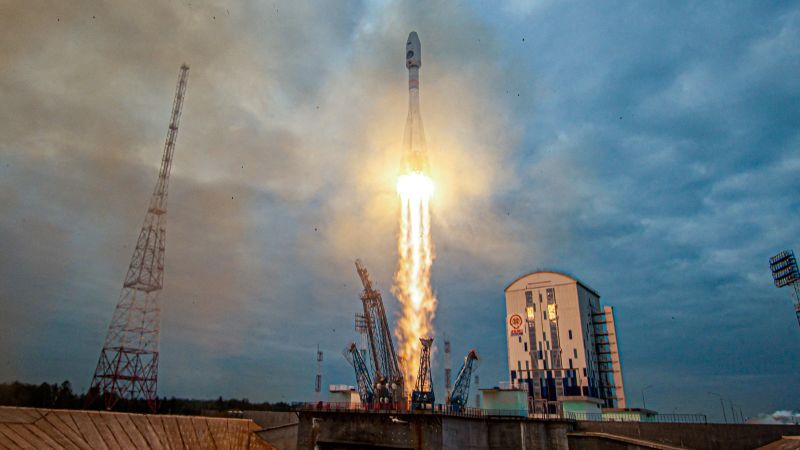Editor’s note: Subscribe to CNN’s Wonder Theory Science Newsletter. Explore the universe with news about fascinating discoveries, scientific advances and more.
CNN
—
Russia’s first lunar mission in decades has ended in failure Spaceship Luna 25 crash into the surface of the moon.
The incident, a blow to Russia’s space ambitions, happened after communication with the robotic ship was disrupted.
The Russian space agency, Roscosmos, said it lost contact with Luna 25 at around 2.57pm Moscow time on Saturday.
“Efforts taken on August 19 and 20 to search for and contact the device were unsuccessful,” the space agency reported.
According to a “preliminary analysis,” Luna-25 “changed to an off-design orbit” before the collision, Roscosmos said.
It was not immediately known what caused the crash.
A specially formed commission will investigate the reasons for the loss of Luna 25, the agency added.
The news comes a day after the spacecraft reported an “emergency situation” as it attempted to enter a pre-landing orbit, according to Roscosmos.
“During the operation, an emergency situation occurred on board the automatic station, which did not allow the maneuver to be carried out with the specified parameters,” Roscosmos shared in a Telegram post this Saturday.
The spacecraft was intended to complete Russia’s first lunar landing mission in 47 years. The country’s last lunar lander, Luna 24, landed on the surface of the Moon on August 18, 1976.
The Luna 25 probe was launched from the Vostochny Cosmodrome in Russia’s Amur Oblast on August 10, putting the vehicle on a quick trip to the Moon.
Luna 25’s trajectory allowed it to overtake India’s Chandrayaan-3 lunar lander, which launched in mid-July, on its way to the lunar surface.
Also called the Luna-Glob-Lander, Luna 25 was on a journey to study the composition of the moon’s soil and the very thin lunar exosphere, or the moon’s thin atmosphere, for a year.
The mission’s trajectory allowed it to overtake India’s Chandrayaan-3 lunar lander, which was launched in mid-July.
The two spacecraft were headed for the South Pole region of the Moon.
Much of the area’s interest comes down to the fact that it remains one of the least explored regions of the Moon. The geographic area is also where scientists believe water is stored on the lunar surface as ice, frozen solid in shadowy craters shielded from the sun.
However, the characterizations that India and Russia ran through the lunar south pole were not entirely accurate, according to astrophysicist Jonathan McDowell, a researcher at the Harvard-Smithsonian Center for Astrophysics. He pointed out that both projects have been underway for more than a decade.
Initially, Roscosmos and the European Space Agency planned to partner on Luna 25, as well as Luna 26, Luna 27 and ExoMars rover.
But that partnership ceased in April 2022 after the Russian invasion of Ukraine, and the ESA Council moved to “suspend cooperation activities with Russia”.
Luna 25 had eight scientific instruments, including specialized devices called spectrometers. One was intended to study the lunar soil and another to detect surface water, according to NASA.
Meanwhile, India’s Chandrayaan-3 has a lander, a propulsion module and a rover, a reconnaissance capability that Russia lacked. The small robotic vehicle can traverse the lunar terrain.
The landing of Chandrayaan-3 could mark the first successful moon landing for the country. India’s most recent attempt ended in failure when Chandrayaan-2 landed in September 2019.
Chandrayaan-3 is scheduled to attempt its landing as early as Wednesday, August 23.
Luna 25 was seen as a testing ground for future robotic lunar exploration missions by Roscosmos. Several future Luna spacecraft were scheduled to make use of the same design.
If successful, Luna 25 would have marked a major step for the country’s civilian space program, which some experts say has faced problems for decades, and would have shown that it could still work on high-profile, high-risk missions.
“They were having a lot of problems with quality control, corruption and funding,” said Victoria Samson, director of the Washington office of the Secure World Foundation, a nonprofit that promotes peaceful space exploration. exterior space, during an interview on Friday.
The news that Russia experienced problems with its spacecraft caused sympathy that resonated throughout the space community.
Thomas Zurbuchen, NASA’s former science chief, said in one posting on social networks that no one in the industry “wishes ill on other explorers.”
“It reminds us that landing on any celestial object is anything but easy and simple,” he said in a post on X, the social media platform formerly known as Twitter. “Just because others succeeded decades ago doesn’t guarantee success today.”

